
BSA is welcoming a number of friends and honored peers to Brooklyn this May as a full circle event takes place in Greenpoint on the East River; the Moniker Art Fair. Our original romance with the streets in Brooklyn included neighborhoods like this one, which served as a laboratory for the Street Art scene that erupted in the mid-late 90s and early 00s.
To see this wild unfettered growth of largely anonymous art-on-the-streets, a truck-full of new art practices spilling into abandoned neighborhoods and neglected buildings, was a time of magic for us, especially after 9/11 forced us to walk the streets just to clear our minds, witnessing the art explosion that had begun in earnest.
To see this wild unfettered growth of largely anonymous art-on-the-streets, a truck-full of new art practices spilling into abandoned neighborhoods and neglected buildings, was a time of magic for us, especially after 9/11 forced us to walk the streets just to clear our minds, witnessing the art explosion that had begun in earnest.
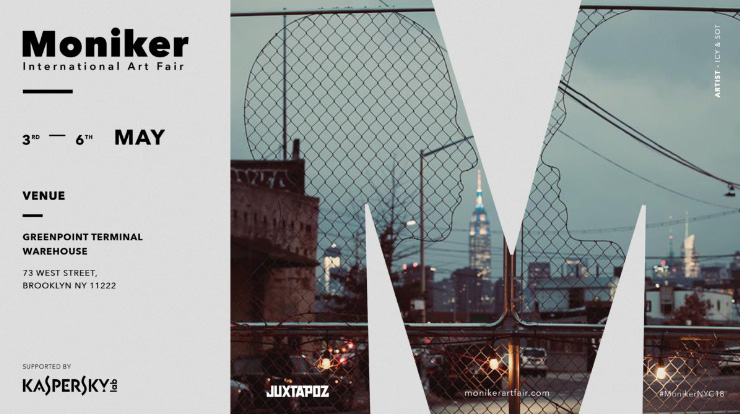
Roughly two decades later, the commercial art world accepts Street Art on its own terms – sometimes with genuine appreciation and understanding, other times as part of a bandwagon of current trends.
Academia and institutions still study the movement at arms length in some ways, perhaps allowing elements of class and orthodoxy to cloud their vision, even while grappling with the earthquake of people-powered art that is reaching directly to art fans through social media.
Now more comfortable with a rebranding of graffiti/Street Art/urban art as something more akin to Contemporary, collectors see that this work is frequently able to address the modern world better than other movements – but we are getting ahead of ourselves.
Now more comfortable with a rebranding of graffiti/Street Art/urban art as something more akin to Contemporary, collectors see that this work is frequently able to address the modern world better than other movements – but we are getting ahead of ourselves.
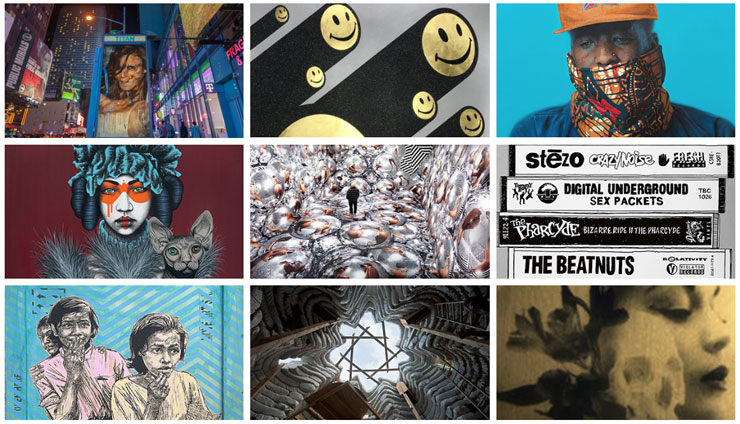
Screenshot of some of the exhibitors at Moniker 2018 in Brooklyn (© Moniker Art Fair)
Art Fairs have allowed Street Art inroads in recent years; first a sort of sideshow, perhaps, more recently as a bonifide category. Moniker, founded by Tina Ziegler, began with this as its foundation. Deeply influenced by her own involvement and exposure as a youth to a uniquely 1990s Californian alchemy of skater, graffiti, surf and hippie subcultures, she wasn’t going to frame this new multi-pronged sub cultural practice of Street Art purely in terms of commerce. She respected it too much. Even as a gallerist for a brief period, she quickly realized it was the process of art making, its intersection with street culture globally, that was critical to its full appreciation.

Starting in London and now in its ninth year, with a small gap to regroup near the beginning, Moniker heads to one of Street Arts’ original home laboratories with her first international edition in an enormous industrial BK warehouse.
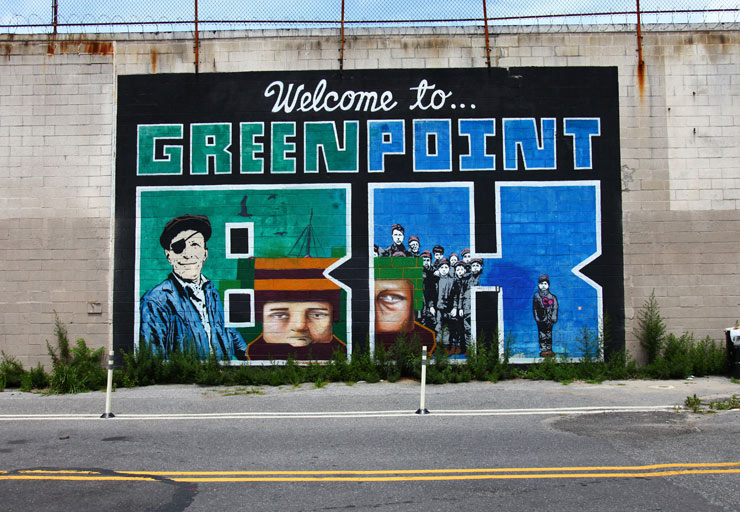
Right in the neighborhood, Greenpoint a decade ago. Artists Skewville, Chris Stain, Veng RWK, Logan Hicks. India Street Mural Project (photo ©Jaime Rojo)
The by-invitation-only event, with strict provisions concerning only original pieces, no overlapping of representation, sincere concentration on individual artists, and the inclusion of artist residencies/installations , Ziegler is firmly redefining your expectations of art fairs. It is very likely she is quietly influencing the model for others as well. Past Moniker events have included academic and educational conferences as well and BSA is ready to help direct that effort when Brooklyn’s second edition pops off in 2019.
BSA spoke with Tina about her choice of location, artists, and exhibitors and what she envisions for the Moniker BK 2018 edition.

BSA spoke with Tina about her choice of location, artists, and exhibitors and what she envisions for the Moniker BK 2018 edition.
BSA: You have chosen the neighborhood of Greenpoint, Brooklyn to site the fair this year. What significance does this location have for you?
Tina Ziegler: It’s been a very deliberate decision to make our international debut at Greenpoint specifically. It’s an area that’s still developing while being a part of of greater Brooklyn, and it’s changing fast enough that you have elements of rugged history and new developments stood side by side.
For obvious reasons that holds huge parallels with the art scenes we work within, and in that respect Greenpoint Terminal Warehouse and the streets around it feel like such a comfortable fit for Moniker.
Additionally it’s an unexpected choice, and I think that’ll help to keep people on their toes, taking in their wider surroundings and understanding the art in context. I fell in love with the venue for that reason – it’s so far away from the standard ‘white tent’ format you’d usually expect to see, and it forces more engagement from our guests.

BSA: Is there a general theme to the show and are there artists whose work exemplify the scene for you at the moment?
Tina Ziegler: Its hard to pinpoint just one or even a few that I feel are representing the breadth of movement all its glory and beauty. But if there’s one thing that binds them all together, it’s a sense of growth and progression within the scene.
By that I mean that I try to make sure I’m presenting work from artists not necessarily because they’re popular, but because they are or have been influential and/or fundamental to urban & contemporary art’s growth.
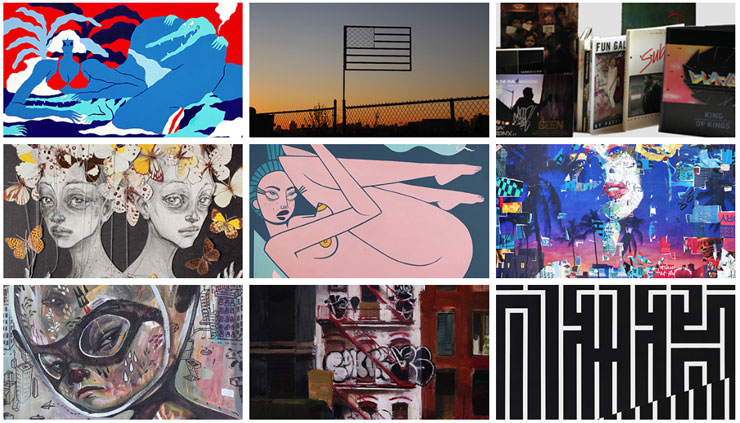
Screenshot of some of the exhibitors at Moniker 2018 in Brooklyn (© Moniker Art Fair)
You’ll see names on our lineup, therefore, who not many might know, but who have been around for longer than people might suspect, contributing to and building the scene in their own way.
Skewville are a part of Brooklyn – they’re a good example of the fun, energy and community engagement that street art allows
Specter will be having only a small role within the fair this year, but he’s always challenged our idea of the public space, and done it in a way that’s so unique, so inspiring and unafraid, that he’s one of my favourite artists creating site-specific public artworks.
The curated aspect of Moniker also means that you’ll see artists who have inspired me personally; those who hold relevance still, and continue to work on their craft while allowing space for younger artists, building a collaborative platform to speak from.
So you’ll see Egle Zvirblyte & Jose Miguel Mendez as an example of that: two artists who I love for their energy, dedication and passion in staying true to their message.
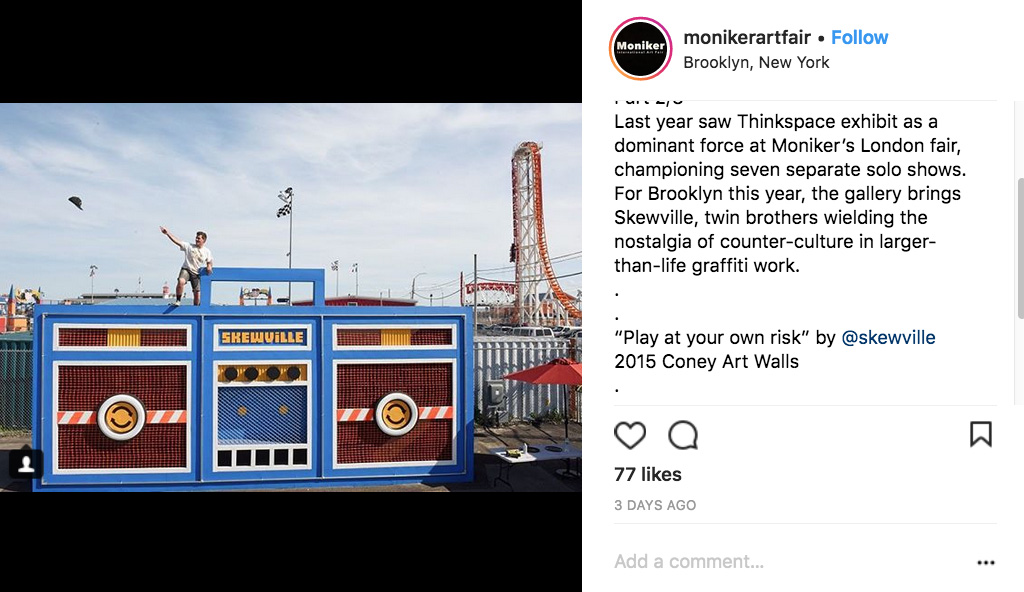
BSA: We’ve been calling this category Urban Contemporary for lack of a better term. Is there any way to categorize such a varied number of street practices which are professionalized here for commercial purposes? Is it even possible or necessary?
Tina Ziegler: When I started working in this space we didn’t even have an idea of where this movement was going – it was all thrown under the umbrella terms of ‘graffiti’ or ‘street art’.
Now, we’ve opened that out into numerous different words and phrases to try and incorporate rate the broad spread of mediums, disciplines and styles: ‘new contemporary’, ‘urban contemporary’ and so on.
Maybe one day we will just call it ‘contemporary art’, but I’m not sure giving it a name is even possible anymore, it’s too big. Is it even necessary, in fact? Our little underground subculture isn’t so underground anymore and has made waves without needing to be properly defined.
But you can say that the defining characteristic of the art at Moniker is urban influence: I actually think the title for Roger Gastman’s new show, Beyond the Streets is really fitting. We came from the streets – from the urban environment – but we’ve gone very, very far beyond that, and have challenged ourselves to redefine what it is we’re doing at a level that’s practically left something as traditional as definitions behind altogether.

For more information please go to Moniker Art Fair HERE.
Other Articles You May Like from BSA:
We're excited because today we get to spend a few minutes on stage with one of our hometown heroes, the artist Tatyana Fazlalizadeh. Leveraging her artistry with her politics with her desire to suppo...
Who are these revered men cast in iron, carved in marble, poured in bronze? What great lengths have they traveled to achieve what high aims, and who decided they were worthy of statuary? Also, how lo...
Free your mind, and the rest will follow. Not only is it a lyric from a 90s pop song, it is a truth that people learn everyday to liberate themselves from attitudes and world views that they’ve...
New brandalism campaign commands attention across 3 Australian Cities at bus stops. They call it #BushfireBrandalism “We’re not a real group. There’s no back story, no history, no narrative – it...
The Halloween Parade through the Village in NYC is tonight, the 40th actually, and you will see a greater number of ghostly guys and ghouls on the bus and subway and hanging out on the street today. O...
 BROOKLYN STREET ART LOVES YOU MORE EVERY DAY
BROOKLYN STREET ART LOVES YOU MORE EVERY DAY










